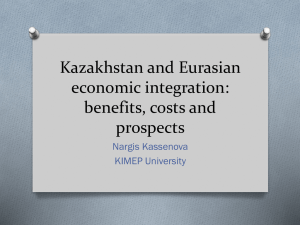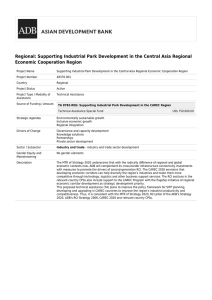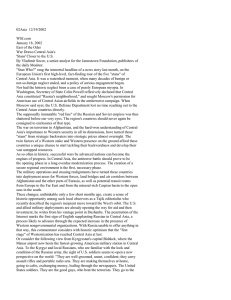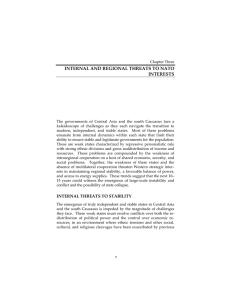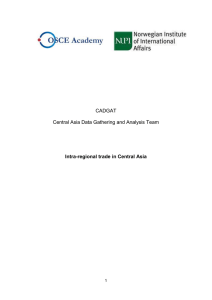Panel 4-Regional Cooperation in Sustainable Energy
advertisement
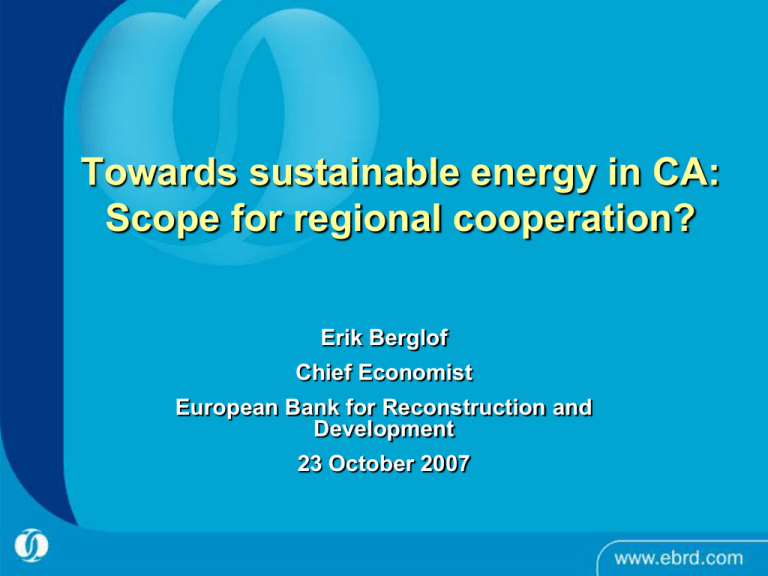
Towards sustainable energy in CA: Scope for regional cooperation? Erik Berglof Chief Economist European Bank for Reconstruction and Development 23 October 2007 Sustainable Energy and Transition Energy security - Growth - Climate change Energy efficiency does not contradict growth Institutional change key to low carbon growth Is there a regional approach? Energy (in)security despite large resources Kazakhstan – production primarily in coalrich north of the country; south of the country (Almaty area) imports electricity Kyrgyz Republic/Tajikistan – high dependency on hydro-electric power; face shortages during winter peak Uzbekistan – unable to meet growing peak demand and resorts to rolling blackouts during peak load period Energy efficiency and carbon intensity – both battles need to be won ENERGY EFFICIENCY FUEL SWITCHING Data source: IEA (www.iea.org/Textbase/stats/index.asp) Ref. year: 2002 Opportunities for savings Substantial savings opportunity in large industrial plants – need for tariff increases to provide investment incentives Large savings opportunities in housing – coordination problem may require subsidies to stimulate investment Need to reduce losses in transmission and distribution – investments may need to be financed through higher tariffs Low tariff levels key to inefficiency Residential electricity tariffs US cents/kWh 12 10 8 6 4 2 0 K ak az n ta s h U ek b z ta is n K z gy r y p Re ic b u Ta n ta s i jik T e m k ur n ta s ni Source: IEA, ERRA and EBRD Note: Data refer to average electricity tariff for 3Q 2006 for Kazakhstan, 2Q 2006 for the Kyrgyz Republic, 2006 for Tajikistan and Uzbekistan and 2005 for Turkmenistan. For SEE and CEB average tariffs are given based on the most recent observations reported by ERRA. C EB E SE Kazakhstan: Sustainable energy requires both efficiency and fuel switch Economy is highly energy intensive, industry in particular The power sector is characterized by regional imbalances Public buildings and urban housing stock highly energy inefficient Power and energy sector, private enterprises, industrial installations, public services and residential buildings all require significant investment Sector reforms and commercialization/private sector participation quite advanced, but bad, low tariffs and deficiencies of regulatory bodies. Kazakh Draft Energy Efficiency Law Economic instruments – removal of subsidies; fiscal incentives, grants, low interest loans to promote efficiency; energy efficiency fund targeting specific sectors Regulations and standards – building codes, appliance and equipment standards, motor vehicle fuel economy standards, etc… Information, technical assistance and labeling – campaigns against energy wastage, training, awareness raising, state monitoring, appliance and equipment labeling, energy audit, technical assistance for Energy Management Systems Creation of Energy Efficiency Agency Voluntary agreements – e.g. with large industrial companies Public infrastructure planning and construction Energy efficiency fund Boost economic competitiveness and enhance energy security Well designed/managed to target investments that also stimulate private sector investments. Focus on areas requiring budgetary support: – Residential housing stock – Public buildings Support for private ESCOs start-ups But higher tariffs most effective way to stimulate energy efficiency investment by private enterprises Industrial Energy Efficiency Clear assessments of energy savings, and their financial implications, essential for private sector Free energy audits and energy management training to large industrial clients + targeted investments Examples in Kazakhstan: Karcement (2005 and 2007); Derbes Brewery (2006) and Efes (2007). Increased demand aligned with tariff increases and increased awareness Energy Efficiency Credit Lines Smaller projects in industry, public buildings and residential sector Technical assistance to participating banks and final beneficiaries – raise awareness and assist participating banks to market the Facility; – build capacity in participating banks – prepare projects for financing, link technical potential to commercial terms Experience: large numbers of beneficiaries reached Awareness raising needed notably in the residential sector Launch in Kazakhstan in early 2008 Bakery in Bulgaria Access to dedicated credit line for energy efficiency Energy efficiency investment into bread production line Cut energy consumption by 59 per cent Slashed 85 per cent of energy costs per annum Municipal infrastructure An integrated approach to municipal infrastructure projects Example: Astana New Transport System – incorporate energy efficient best practice – energy efficiency improvements in district heating, subject to conditions on tariff reform and creditworthiness being met. Finance through private sector Energy Service Companies (ESCOs) – design, install, finance and guarantee minimum performance of energy savings measures, particularly in public buildings. – Once private market developed, establish public ESCO Regional cooperation Difficult because no direct spillovers from investments, but many challenges are similar Energy security has regional dimension “Common” financial system (Kazakh banks) Demonstration impact - share experience – CAREC Institute? Establish regional fund (cf. Bota Fund) Conclusion Renewables important but expensive Focusing on energy efficiency more effective Improved regulation and increases in tariffs Sharing knowledge and experience through regional cooperation (e.g. CAREC Institute) Exploiting “common” financial system Bulgaria: Energy efficiency success Energy intensity declined by around 30% from 1997 to 2004 0.6 0.5 0.4 0.3 89 990 991 992 993 994 995 996 997 998 999 000 001 002 003 004 9 1 1 1 1 1 1 1 1 1 1 1 2 2 2 2 2 Kg of oil equivalent per $ of GDP in constant 2000 prices Source: WDI High energy intensity: scope for energy efficiency Total primary energy supply per GDP (PPP) in toe/thousand-2000 US$PPP, 2004 1.4 1.2 1 0.8 0.6 0.4 0.2 Source: IEA EU-25 USA PRC Russia Kyrgyz Republic Tajikistan Kazakhstan Turkmenistan Uzbekistan 0 High losses in electricity distribution/transmission Distribution/transmission losses in per cent of total production, 2004 35 30 25 Source: IEA PRC USA EU-15 Russia Uzbekistan Turkmenistan Tajikistan Kazakhstan 0 Kyrgyz Republic 20 15 10 5 Key challenges Need to increase energy efficiency Need to rehabilitate old generation and transmission/distribution facilities Need to bring new efficient generating capacity Require adequate incentives


